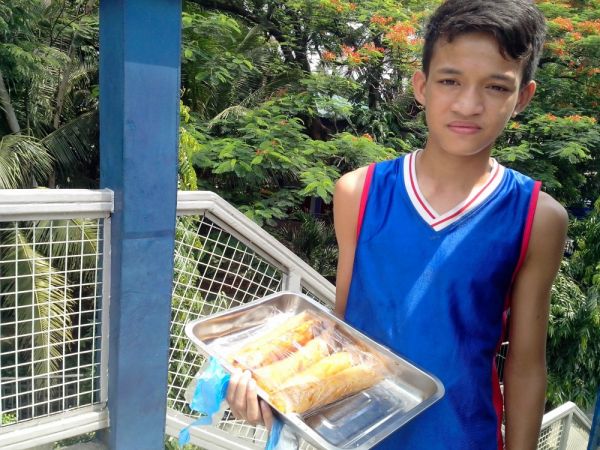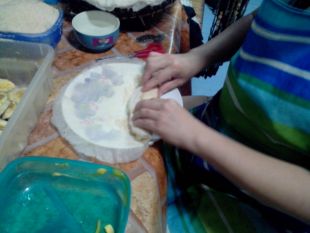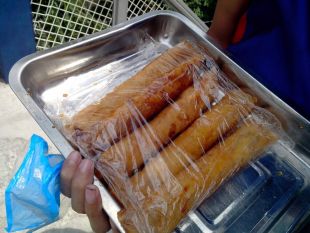The Philippines Asks, Is Child Labor Abusive or a Cultural Tradition?

Anthony and his banana fritters, which he sells to help pay for his schooling as well as offset the costs of his own upbringing.
A bit over five feet tall, skinny and meek, Anthony Eusebio looks like a 10-year-old boy and not the 15-year-old teenager that he is. At 15, an age when many young people like him are thinking about who they’ll ask to the prom, the courses they’ll take in college and how to stay awake in trigonometry class, Anthony is more concerned with how he’ll finish elementary school.
He had to stop studying for a while because his parents could not afford to pay for his schooling. His mother is a housewife and his father a construction worker, collecting an average monthly salary of $270. It was only recently that Anthony was able to resume his schooling, removing him from the list of millions of young Filipinos who drop out, mostly because of poverty.
He lives in Quezon City, population 3.17 million. According to the latest data from the Department of Education, the number of Filipino students aged six to 15 who have dropped out or never attended school has reached 5.6 million — higher than Quezon City’s entire population. This has alarmed Quezon City Mayor Herbert Bautista, who has proposed joint public-private efforts to increase information dissemination on this issue.
Anthony has to sell banana fritters before or after his classes to help pay for his expenses. The whole of Katipunan Avenue in Quezon City is his marketplace, and he switches spots often while selling the snacks. I usually see him standing at the blue-and-white overpass that leads to Ateneo de Manila University, one of the most expensive schools in the country. Anthony calls out to students and passersby, trying to entice them to try a fritter. He does this every day, either from 9 to 11 a.m., just before classes commence at Balara elementary school, or on his way home in the afternoon, from 3 to 5 p.m.

Martha makes the fritters that are sold by her team of child vendors.
“From every piece of turon (banana fritter) I sell at P10 (23 cents), I get P2,” he said. He typically sells 15 or more pieces per day, for a total profit of P30 — less than $1 USD. There are a number of Anthonys on Katipunan Avenue. I met another one, Noli, who was selling banana fritters — and watching over his younger brother at the same time — in front of a fast-food restaurant.
Anthony and Noli both told me they got the snacks they sell from Martha (not her real name), a neighbor in their area. “There are 15 of us, I think,” Noli told me, adding that he takes home P4 for every turon he sells for P10, and gives half of his earnings to his mother, who works as a maid. The other half goes to him.
Noli, Anthony and Martha live in Merrytown, an ironically named neighborhood that’s rife with crushing poverty. It was raining the day that I went there. The alley leading to Martha’s house is narrow and dark, but her home and her calm, cheerful demeanor combat the dreary environs. Her small living area, not more than 16 square meters, is filled with bundles of bananas — a thousand pieces, she told me. She was making banana fritters when I arrived. At 39 years old, she looked younger with her fair skin and kind smile.
“It [having children sell banana fritters] all started when a boy approached me one day and asked me if he can sell some so he can have money to help his family,” she said, adding that she asked the child if it was okay with his parents before agreeing to the deal.
That was in 2012. Less than a year later, Martha found herself with a “staff” of 15 kids who report to her every afternoon and hand over 60 to 80 percent of their earnings, plus whatever is left of the banana fritters. She earns an average of P1,400 ($32 USD) every day.
The children automatically deduct a percentage of the money and keep it for themselves, an honor-system arrangement. “She knows that whatever we give her for the day is the real amount of what we were able to sell,” said Anthony. This trust was an expected byproduct of the ties that Martha has with the families of the children. She knows their struggles. “Most of [the children] come from broken families,” she said. And she stressed that she makes sure she talks to the parents of the children at length before she takes them on as vendors. “I’m not doing anything wrong, I believe,” she said.

The system that puts money in the pockets of the children and their families is not without controversy.
Martha’s caution stems from the fact that child labor is a sensitive topic and a persistent problem in the Philippines. The Department of Labor and Employment defines child labor as the “illegal employment of children below the age of 15, where they are not directly under the sole responsibility of their parents or legal guardian, or the latter employs other workers apart from their children, who are not members of their families, or their work endangers their life, safety, health and morals or impairs their normal development including schooling. It also includes the situation of children below the age of 18 who are employed in hazardous occupations.”
The latest survey from the National Statistics Office showed that in 2011, 18.9 percent, or 5.59 million of the 29.019 million Filipino children aged five to 17 years old are already engaged in some form of employment to earn money for themselves or their families, almost always in the informal and agricultural sectors and in the food and garment industries, where they are exposed to various safety and health hazards.
But there are cultural nuances. According to the International Labor Organization’s International Programme on the Elimination of Child Labour, children in the Philippines are “impelled to work from an early age because of the centuries-old tradition that the child must work through solidarity with the family group, so as to compensate as much as possible for the economic burden that he/she represents and to share in the maintenance of his/her family, which is usually a very large one.” ILO-IPEC added that, “In the Philippines, families particularly value helpfulness and responsibility-sharing.”
Indeed, Martha insisted she is helping the children who work for her. “There are things they learn from doing this,” she explained. “They learn that there are other ways to earn money than to steal from others, or commit crimes in the streets.”
She also said she makes sure they are safe and asks them if anyone harasses them because of their age. “Some children get picked on by barangay (village) officials who ask them to give them a banana fritter for free,” she scoffed. “I tell the kids that they should refuse. Those who hold higher posts here in our area do not even do that.”
And in some cases, she said strangers can be extraordinarily kind to the kids. “Our youngest here, nine-year-old Juancho, is a jolly little kid. The people love him,” she said. “One time he told me that someone who brought banana fritters from him gave him P500. There’s another boy who doesn’t have any slippers. A customer promised him that he will give him a pair.”
I asked Anthony and Noli what their parents think of what they are doing. Noli said they approved of it, and Anthony said the same. “It helps because I can have an allowance of my own,” he said proudly. And though Anthony is way behind his studies and admits he is not sure if he will be able to finish high school, he tries his best everyday, waking up early, selling his banana fritters, going to his classes.
“I want to be a seaman and see the world,” he said, sounding older than his years.









